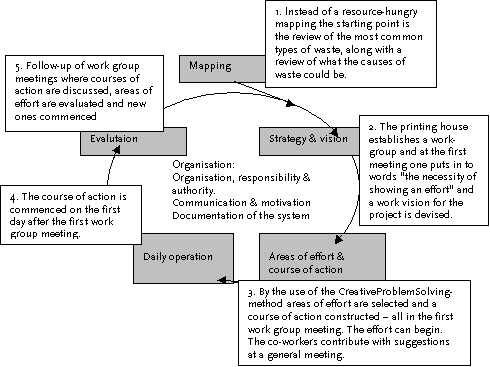|
Målrettet papirstyringsværktøj til avistrykkerier SummaryThe average percentage of waste paper from Danish newspaper printing houses is 8-12%3. With an accumulated consumption of 230.000 tons of newspaper printing paper per annum, even a moderate reduction in percentage of wastepaper represents a massive amount of paper – with a proportionate beneficial effect on the environment. Newspapers are produced on relatively uniform conditions and therefore exchange of experience is obvious. The uppermost goal of this project has been to develop a goal oriented paper management tool for the newspaper printing houses. The tool developed in this project has parallels to the standardised management systems (ISO 14001, EMAS, ISO 9000 etc.) but is specifically relevant to newspaper printing houses. Seen from a management-theoretic point of view, the method in use links to the Kaizen management philosophy of completion and anchoring of continuing change. In this context the method has been simplified and more intervening in relation to involvement of co-workers than Kaizen usually is. See diagram.
Principles in the goal oriented tool. Organisation, responsibility and authority The organisation is meant to be as simple as possible. A work group is established which ensures a broad representation of both workers and management; knowledge, experience, competence in decision-making, and drive. The composition of the work group can vary depending on which areas of effort are relevant. The work group exhibits responsibility by meeting at regular intervals and following up on the courses of action decided. The courses of action place the responsibility for the specific areas of effort. Everyone in the firm has a joint responsibility when it comes to minimising the waste of paper. The process consultant – the neutral outsider – ensures that the process is in progress; that meetings are held, that the courses of action are revised, that summaries are written etc. Communication and motivation From the beginning of the project a registration of the paper waste is established so graphs can be produced and show the trends in the amount of waste. All co-workers can via the graphs see the trends – the graphs are an important motivating factor. Tools for registration have been developed which are easily compatible with the specific needs and opportunities of any firm. There will be held meetings for all co-workers – a minimum of one at the project start. In the continuing work around the minimisation of waste it is important that co-workers can come in with input. Therefore it is ensured at the start of the project that co-worker input is taken, evaluated and all input receive feed back, whether or not they will be used in the courses of action. Finally solutions are found, courses of action are made and there is a follow up on all new areas of effort. Most likely there will be areas of input chosen where communication plays a vital role, e.g. communication between the departments during production. Documentation of the system A documentation of the commenced work consists partly of the courses of action (in which it can be seen what should occur, who is responsible and when there will be a follow-up) and partly of the registration that shows the development in the paper waste. By the start of the project two criteria of success were established:
The two newspaper printing houses have chosen to continue the process of change whilst the third is taking a break. The reason for this break is that the printing house has bought a new rotating press and is moving to a new location with new conditions of production. As early as in the project-period special consideration had to be taken for the future changes. The main area of effort was the handling of the return paper and while there can be demonstrated a marked reduction in this there cannot be proved any reduction in the overall waste percentage. The two remaining printing houses have in the project-period demonstrated a marked reduction of 1-2 per cent of paper bought, equivalent to 150-300 tons of paper per annum. For the printing houses this is a considerable minimisation of paper waste. The success has to be seen with the fact that there has only been time to work with the areas of effort within the printing houses. There is, as mentioned earlier, several areas of effort in other sectors of newspaper production – e.g. editorial offices, distribution and general sale. The potential for the external areas of effort are expected of the same magnitude as the internal. The three firms have acknowledged that the project has not given technical solutions that one could not have implemented oneself. The main advantage of the project is that the waste paper has been put on the agenda and applied systematically at a speed that is suited for the individual firm. It is an advantage, if not a precondition, that the project is being kept on track by an independant process consultant. Communication of the results The target group for the project – top management, middle management and the normal employees – are not the target group for this report which was moulded after the Danish Ministry of Environment standards for reporting on environmental projects. In a project that has as a precondition the involvement on all levels there has, apart from the report to the Ministry of Environment, been made a goal-oriented communication in the shape of:
|
